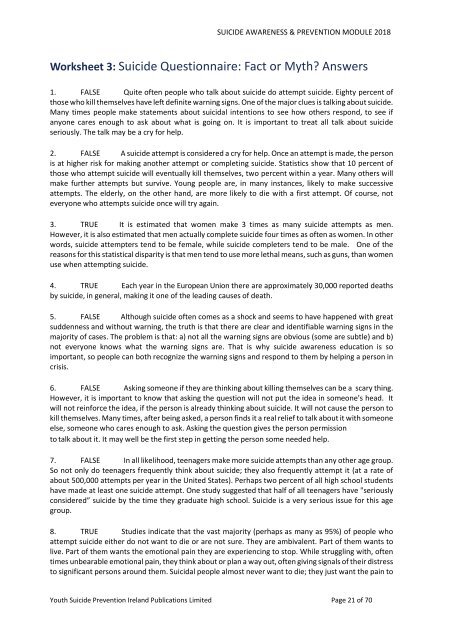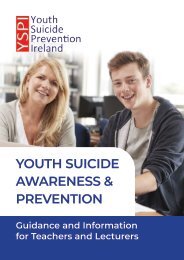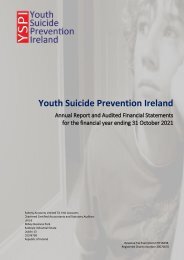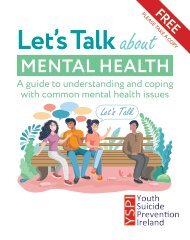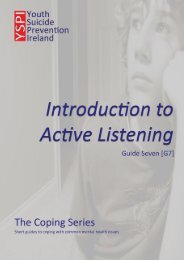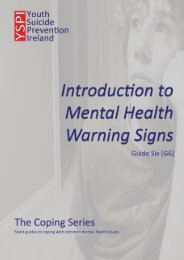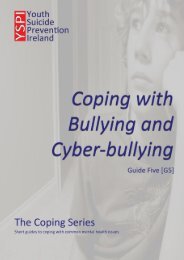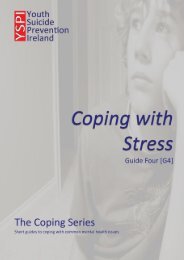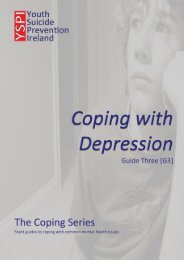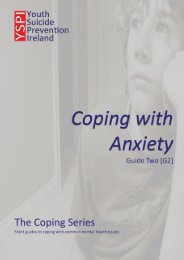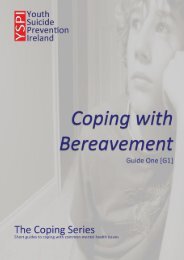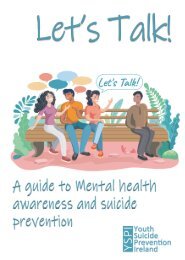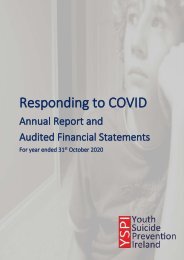Teaching Suicide Awareness and Prevention 2019
Lesson Plans, Worksheets and Quizzes for Secondary School Teachers
Lesson Plans, Worksheets and Quizzes for Secondary School Teachers
Create successful ePaper yourself
Turn your PDF publications into a flip-book with our unique Google optimized e-Paper software.
SUICIDE AWARENESS & PREVENTION MODULE 2018<br />
Worksheet 3: <strong>Suicide</strong> Questionnaire: Fact or Myth? Answers<br />
1. FALSE Quite often people who talk about suicide do attempt suicide. Eighty percent of<br />
those who kill themselves have left definite warning signs. One of the major clues is talking about suicide.<br />
Many times people make statements about suicidal intentions to see how others respond, to see if<br />
anyone cares enough to ask about what is going on. It is important to treat all talk about suicide<br />
seriously. The talk may be a cry for help.<br />
2. FALSE A suicide attempt is considered a cry for help. Once an attempt is made, the person<br />
is at higher risk for making another attempt or completing suicide. Statistics show that 10 percent of<br />
those who attempt suicide will eventually kill themselves, two percent within a year. Many others will<br />
make further attempts but survive. Young people are, in many instances, likely to make successive<br />
attempts. The elderly, on the other h<strong>and</strong>, are more likely to die with a first attempt. Of course, not<br />
everyone who attempts suicide once will try again.<br />
3. TRUE It is estimated that women make 3 times as many suicide attempts as men.<br />
However, it is also estimated that men actually complete suicide four times as often as women. In other<br />
words, suicide attempters tend to be female, while suicide completers tend to be male. One of the<br />
reasons for this statistical disparity is that men tend to use more lethal means, such as guns, than women<br />
use when attempting suicide.<br />
4. TRUE Each year in the European Union there are approximately 30,000 reported deaths<br />
by suicide, in general, making it one of the leading causes of death.<br />
5. FALSE Although suicide often comes as a shock <strong>and</strong> seems to have happened with great<br />
suddenness <strong>and</strong> without warning, the truth is that there are clear <strong>and</strong> identifiable warning signs in the<br />
majority of cases. The problem is that: a) not all the warning signs are obvious (some are subtle) <strong>and</strong> b)<br />
not everyone knows what the warning signs are. That is why suicide awareness education is so<br />
important, so people can both recognize the warning signs <strong>and</strong> respond to them by helping a person in<br />
crisis.<br />
6. FALSE Asking someone if they are thinking about killing themselves can be a scary thing.<br />
However, it is important to know that asking the question will not put the idea in someone's head. It<br />
will not reinforce the idea, if the person is already thinking about suicide. It will not cause the person to<br />
kill themselves. Many times, after being asked, a person finds it a real relief to talk about it with someone<br />
else, someone who cares enough to ask. Asking the question gives the person permission<br />
to talk about it. It may well be the first step in getting the person some needed help.<br />
7. FALSE In all likelihood, teenagers make more suicide attempts than any other age group.<br />
So not only do teenagers frequently think about suicide; they also frequently attempt it (at a rate of<br />
about 500,000 attempts per year in the United States). Perhaps two percent of all high school students<br />
have made at least one suicide attempt. One study suggested that half of all teenagers have "seriously<br />
considered” suicide by the time they graduate high school. <strong>Suicide</strong> is a very serious issue for this age<br />
group.<br />
8. TRUE Studies indicate that the vast majority (perhaps as many as 95%) of people who<br />
attempt suicide either do not want to die or are not sure. They are ambivalent. Part of them wants to<br />
live. Part of them wants the emotional pain they are experiencing to stop. While struggling with, often<br />
times unbearable emotional pain, they think about or plan a way out, often giving signals of their distress<br />
to significant persons around them. Suicidal people almost never want to die; they just want the pain to<br />
Youth <strong>Suicide</strong> <strong>Prevention</strong> Irel<strong>and</strong> Publications Limited Page 21 of 70


